We offer the an unrivalled service, from a free quotation which will give expert advice to find the appropriate solution, at competitive rates. You will have an expert carrying out the work using state of the art equipment and techniques, to ensure the job goes smoothly.
We often remove trees in challenging environments and will choose an appropriate course of action to work on them. Given the space we will fell trees but where surroundings dictate, and a delicate approach is required we will sectionally dismantle them using rigging systems.
The felling or dismantling of trees is inevitable where the position of the tree poses a hazard if it were to fail of its own accord.
Tree removal is necessary when structural integrity is compromised or when a tree is diseased or is dying, It may also be necessary if a tree is in conflict with property or structure, whether this is root damage to services, driveways or paving, or trees causing subsidence or heave to a building – where the tree may be affecting soil conditions.
As with all of our work the waste generated on all jobs is recycled in wood chip, logs and compost. Nothing is wasted!
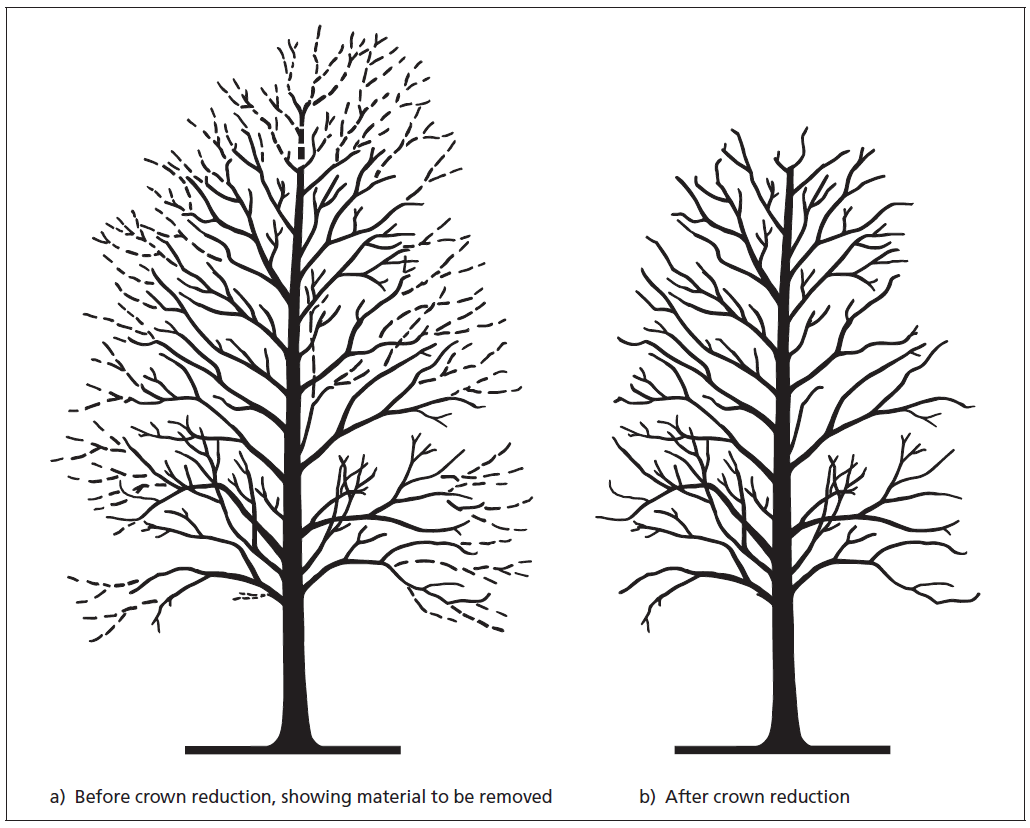
The reduction in height and spread of the canopy of a trees. We use crown reduction to, make the tree more suited to its immediate environment or to reduce the effects of shading and light loss, etc.
The final result should retain the main framework of the crown, and so a significant proportion of the leaf bearing structure, and leave a similar, although smaller outline.
Cuts are made as small as possible and in general not exceed 100mm diameter unless there is an over-riding need to do so.
Not all species are suitable for this treatment and crown reduction should not be confused with ‘topping’, an indiscriminate and harmful treatment.
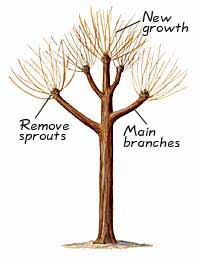
Pollarding is a pruning system in which the upper branches of a tree are removed, promoting a dense head of foliage and branches. It has been common in Europe since medieval times and is practised today worldwide, primarily to maintain trees at a desired height.
Pollarded trees tend to live longer than other specimens because they are maintained in a partially juvenile state, and they do not have the weight and sail effect in the top part of the canopy.
The practice is acceptable for a number of native trees and non native trees too. We may recommend this management technique where the length of a trees life may be dramatically increased, or to provide screening at a certain height.
Crown thinning is a pruning technique we use on broad leaf trees. Crown thinning is the selective removal of stems and branches to increase light penetration and air movement throughout the crown of a tree. The intent is to improve a tree’s structure and form while making life uncomfortable for tree pests.
The British Standard recommends a maximum reduction of 30% which is a set to not unduly stress, or shock trees by excessive pruning. Great care must be taken to ensure the correct cuts are made to prevent “bushy” regrowth and maintain uniform canopy density.
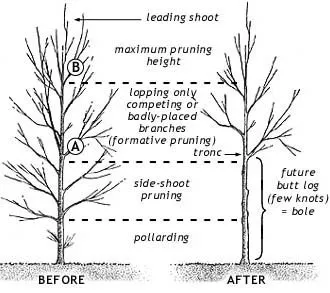
Describes the removal of dead, diseased, crossing or rubbing branches. It is good practice to remove these problems as some pose as a hazard now and others will develop into a hazard in the future.
Dead branches may fall from the tree and hit a person or property, while a diseased branch if not removed may spread the disease further around the tree and cause further problems in the future.
Any branch with a tear wound caused by wind, vandalism or vehicle contact is more prone to failure and is also more likely to get a disease or infection while the bark is broken. The removal will aid the tree to improved health.
Many trees will grow with crossing or rubbing branches, this contact causes wounds as the friction caused by movement in the wind wears through the bark and exposes the tree to the spores and bacteria in the air.
Trees also have structural weaknesses where the tree has grown a branch in a way which is mechanically weak. Depending on what is beneath the tree and how severe the weakness appears to be it can be necessary to remove these limbs.
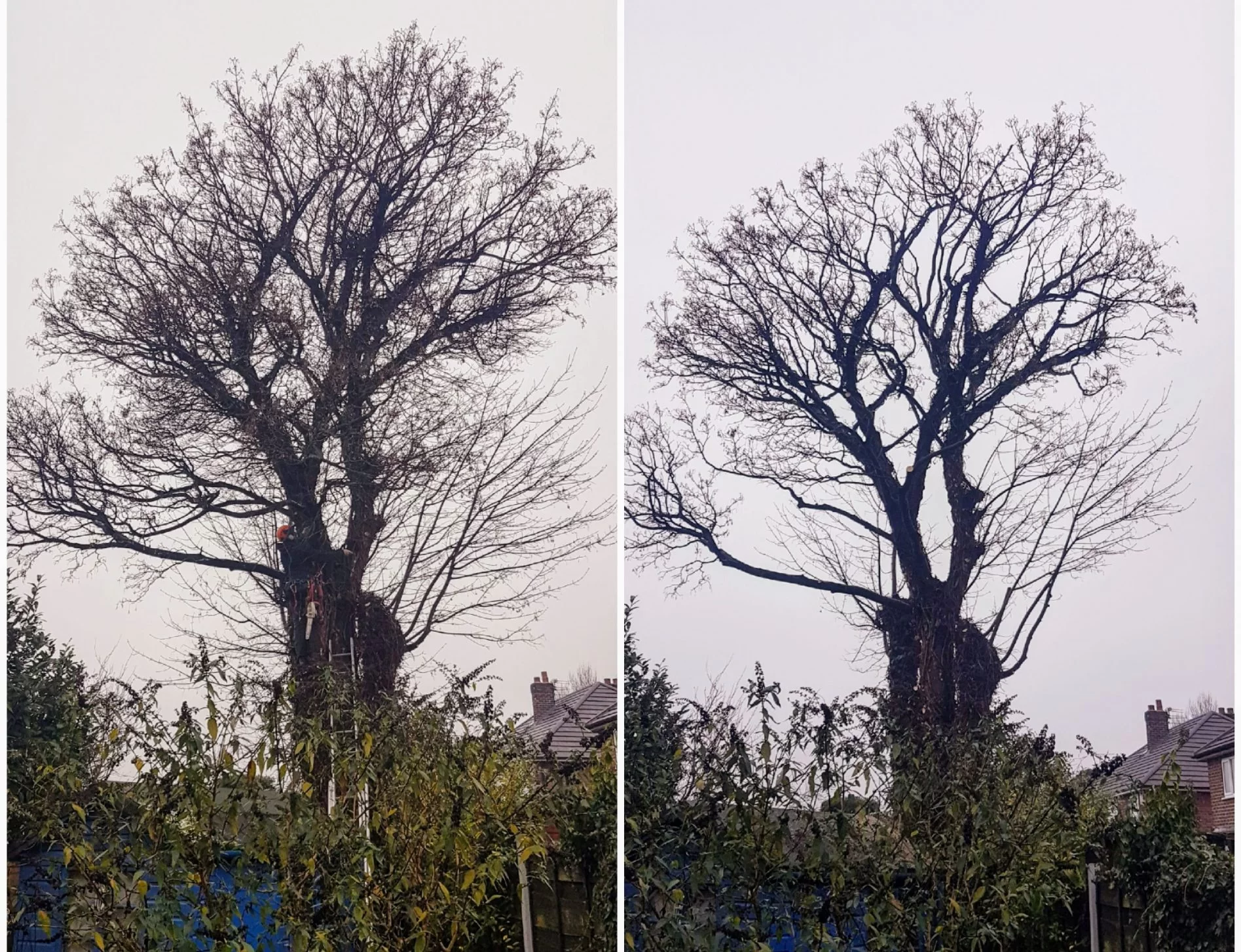
We can supply and plant trees to suit your requirements, whether you need something small or large, we offer the highest level of expertise and advice and will help give you options and the correct information to ensure a happy tree and happy customer for the long term.
There are a number of considerations we can help you assess including:
Typical root type & suitability for planting near buildings or structures.
There is lots to think about and we will help eliminate the unsuitable.
We use both visible and hidden support systems for the trees first 2-3 years and will tailor the system to your requirements. The traditional “Tree Stake” where the tree is supported by a post by a tree tie is the most cost effective method and is normally adequate for trees up to 3m tall in most situations. The hidden system is suitable for larger trees up to 8m and where a stake may be deemed as not in keeping with the design. This system anchors the tree to the ground by cables driven deep into the surrounding soil.
Soil is a major consideration when planting and while often the plants and trees in the immediate area will give clues to soil type, structure and condition we can carry out simple tests to further indicate the need for soil treatment or eliminate tree species which may not thrive in the conditions present.
Top dressing is the top layer you cover the soil with, again this can make a significant impact on the progress your newly planted tree makes as it can reduce the water loss and competition with weeds or grass. We will give recommendations on the best method for each tree as a part of the design process.
All of our tree stock is sourced from reputable UK nurseries with whom we have long standing working relationships, this gives you the peace of mind that having picked the right species, an excellent quality example of the species will be supplied.
After care must be considered including a watering and feeding regime that you or we can implement ensuring that your new tree gets the best possible start in its new home. In some cases an irrigation system is the most efficient method for watering and is particularly popular with customers who are not always able to find the time to water each plant individually.
As the Leicestershire tree experts we look forward to helping you design and plant a scheme to fit your lifestyle and garden.
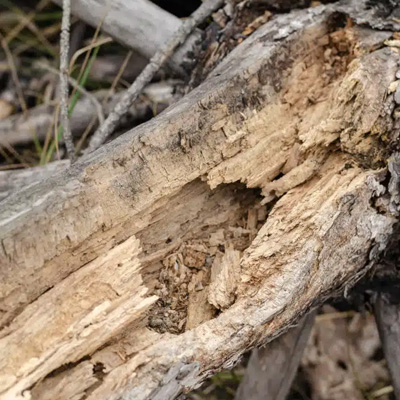
This describes the removal of dead/dying branches. It is in some cases a signal that a tree is under attack or stressed. In some instances however it is a perfectly natural part of a trees life cycle, and they may shed and replace a branch in the same way as a cat or dog sheds its fur.
The removal of these branches may be necessary, if for example your tree is over a highway or footpath or you car or house is beneath it, we may recommend the removal of large deadwood (>25mm).
If however the deadwood is over a lawn or flowerbed it may not pose a significant hazard to yourself or your property and may not require removal.
This deadwood is host to bats, fungi and many insects as a breeding ground and home. Dead wood is a vital habitat for them, the needless removal of deadwood will reduce the habitat available for these species, which will adversely effect the rest of the food chain.
While many trees will naturally form their adult shape as they grow, others need a little assistance to promote a clear trunk and a well-spaced canopy of branches. It is good practice to keep an eye on young trees and carry out formative pruning as required.
For example a codominant stem or included bark can be seen very early and with appropriate pruning will solve the issue and allow the tree to have a full life Though such stems may look fine to the casual observer, they may actually be dangerous.
The term “codominant stems” is used to describe 2 or more main stems (or “leaders”) that are about the same diameter and emerge from the same location on the main trunk. Codominant stems tend to fail much more often than others, especially in storms.
Work carried out in the formative years of a tree will minimise the size of any wounds caused by pruning, which are the entry point for pests and diseases.
This example shows typical codominance, these pictures illustrate the two possible outcomes.
Visit us
Business Hours